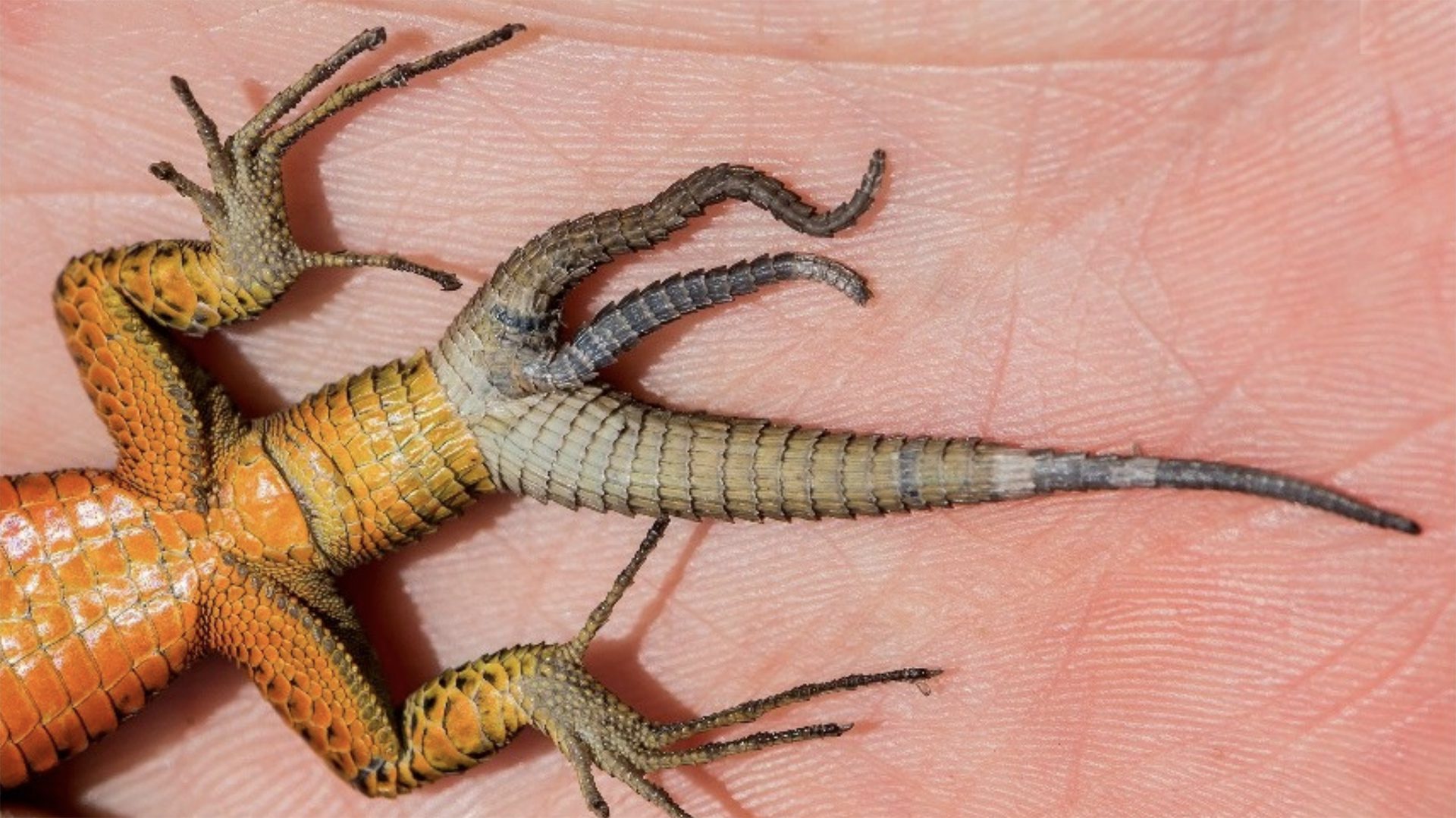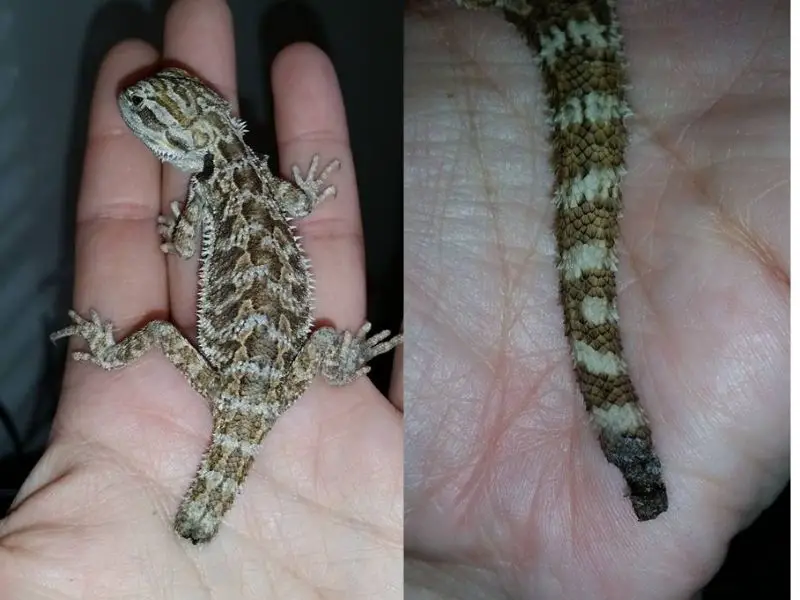Bearded dragons are popular pet lizards known for their friendly personalities and unique looks. As reptiles, bearded dragons have long tails that serve important functions like balance, fat storage, and communication. However, their tails are also relatively fragile and can potentially be lost if mishandled or injured. So can a bearded dragon lose its tail? The short answer is yes, but there are important factors to understand about tail loss in bearded dragons.
What Causes Tail Loss in Bearded Dragons?

There are a few potential causes of tail loss in bearded dragons:
- Injury: The most common reason for tail loss is injury, usually from improper handling. Bearded dragon tails are delicate and can fracture if pulled or twisted. Falls or impacts against hard objects can also fracture the tail.
- Fighting with other bearded dragons: Bearded dragons housed together may bite or grab each other’s tails, sometimes resulting in tail fracture and loss.
- Stuck shed skin: If shed skin is not properly removed it can constrict blood flow leading to tail tip death and eventual loss.
- Medical conditions: Certain medical conditions like metabolic bone disease can weaken the tail, making it more prone to fracture and loss. Infections may also contribute.
- Predator attacks: In the wild, failed predator attacks are a cause of tail loss in bearded dragons and other lizards.
So in summary, injury and fighting are the most common reasons pet bearded dragons experience tail loss, though medical abnormalities can also play a role. Proper handling and housing is key to preventing trauma and fracture.
What Happens When a Bearded Dragon Loses Its Tail?
When a bearded dragon’s tail is fractured or severed, here is what happens:
- The lizard will quickly detach the broken portion of tail in a process called autotomy. This limits blood loss and prevents the spread of infection.
- There will be some bleeding when the tail detaches. Applying pressure with a clean cloth can help control blood loss.
- The broken tail tip will not regrow. Lizards only have a limited ability to regenerate lost tails.
- A stub will remain where the tail broke off. Over time this will form a smooth stump that seals off the broken bone ends.
- Losing a large portion of the tail can impact balance initially until the lizard adapts its movement.
- Appetite may decrease for a few days after tail loss due to stress. Nutritional support may be needed.
- With proper first aid and wound care, most bearded dragons recover fully from tail loss.
So in summary, the tail detaches rapidly, bleeds briefly, leaves a small stub, impacts balance temporarily, and may reduce appetite, but most bearded dragons bounce back well when given proper care and time to adjust.
Long Term Effects of Tail Loss on Bearded Dragons
While losing its tail does not affect a bearded dragon’s long-term health or lifespan, there are some lasting effects:
- Reduced fat storage: The tail serves as an important fat storage site. Loss of the tail reduces energy reserves.
- Impact on communication: Bearded dragons use their tails to communicate, so loss can impact social behavior.
- Reduced balance/climbing ability: It can take weeks or months to fully adapt movement and balance without a full tail. Climbing ability may be slightly reduced long-term.
- Changed appearance: The smooth tail stump has a different look than a full, thick tail.
- Increased stress: Tail loss is a stressful event that may make a bearded dragon more skittish or defensive long-term. Proper handling can minimize lasting changes in temperament.
- Higher risk of future tail loss: Once fractured and regrown, the tail is weaker and more prone to future fracture.
So while tail loss does not directly impact health or lifespan, it can have subtle long-term impacts on appearance, behavior, balance, and risk of future injury that owners should be prepared for. With patience and proper care, most bearded dragons adapt well over time.
Steps to Aid Recovery After Tail Loss

If your bearded dragon does lose part of its tail, here are some steps to help recovery:
- Gently clean the broken tail end with diluted antiseptic to prevent infection. Avoid over-cleaning.
- Apply steady pressure with a clean towel for 5-10 minutes to control any bleeding.
- Bandage the tail if bleeding persists. Use non-stick bandage pads.
- House the bearded dragon separately while recovering to prevent aggression from cagemates.
- Monitor appetite closely. Assist feed if needed. Provide ample calcium and multivitamins.
- Allow extra basking time to support wound healing.
- Limit handling initially to reduce stress.
- Watch for signs of infection like swelling, pus, redness, or foul odor. Seek vet care if these develop.
- Avoid soaking the tail for 2-3 weeks until healed.
- Expect someawkward movement and instability initially as they adapt balance.
With appropriate first aid, monitoring, nutrition, and housing adjustments, most bearded dragons make a full recovery and adjust to life with a shorter tail. Patience and empathy for their stress are key.
Conclusion
In summary, bearded dragons can definitely lose all or part of their tails due to injury, fighting, shedding problems, medical issues, or predation attempts. Tail loss is traumatic and impacts balance, fat reserves, social behavior, appearance, and risk of future injury. However, with proper care during recovery, most bearded dragons bounce back well and live a full healthy life despite a shortened tail. Being aware of the causes of tail loss and recovery steps allows bearded dragon owners to be prepared and provide the best care if their lizard suffers this traumatic event. With some time and TLC, beardies without tails still make excellent pets!
FAQs About Can a Bearded Dragon Lose Its Tail
What are the common reasons for a bearded dragon to shed or drop its tail?
Common reasons for tail shedding in bearded dragons include stress, injury, or feeling threatened. They may also shed their tails if the tail is damaged or if they perceive it as a threat or hindrance.
Can the tail regrow fully, and does it look the same as the original?
While bearded dragons can regenerate their tails, the new tail may not be a perfect match in terms of appearance. The regenerated tail may have a slightly different texture, coloration, or length compared to the original.
Are there any health concerns or risks associated with tail loss in bearded dragons?
Tail loss itself is not typically a health concern, as bearded dragons can survive without their tails. However, the underlying cause of tail loss, such as injury or stress, should be addressed to prevent further issues.
Can tail loss be prevented or minimized through proper care and handling?
Tail loss can be minimized by handling your bearded dragon gently and providing a stress-free environment. Avoid situations where they may feel threatened or trapped, as these are common triggers for tail shedding.
Are there any signs or behaviors that indicate a bearded dragon is about to lose its tail?
Bearded dragons may display signs of distress, agitation, or puffing up when they feel threatened or stressed, which can precede tail shedding. Observing these behaviors can serve as a warning sign.
How long does it typically take for a bearded dragon to regenerate its tail after loss?
The tail regeneration process in bearded dragons can take several months. The exact duration varies from individual to individual, but with proper care, the regenerated tail will gradually develop over time.




